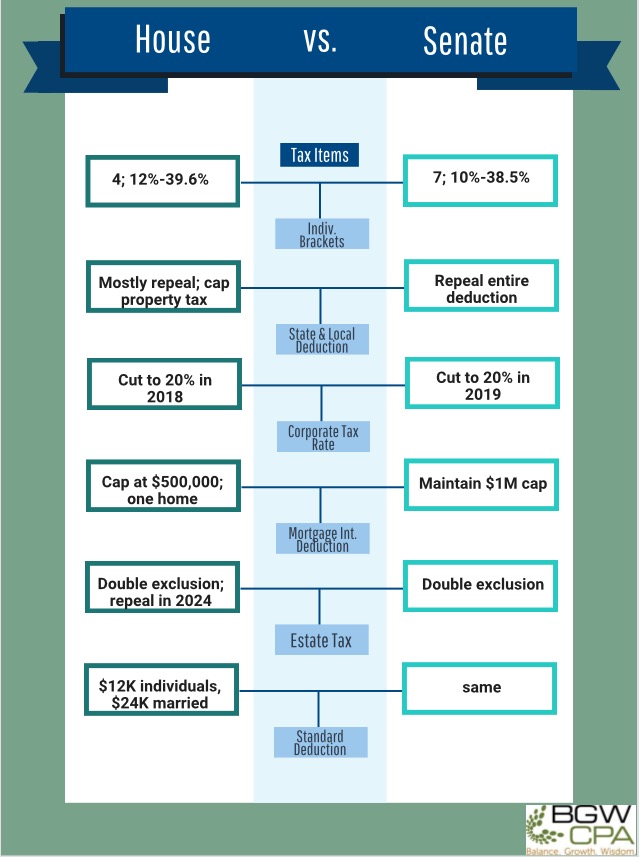Speaking before a crowd in Indiana yesterday, President Trump unveiled the GOP tax plan. Calling it a “once-in-a-generation opportunity”, the president advocated once again for sweeping tax cuts and a simplification of the tax code. For weeks now, Trump has working to crank up public support for both. Yesterday, he gave the specifics on how he and the GOP plan to do it. Note that the plan does bear striking resemblances to Trump’s plan released back in April.
Here are the proposed changes in the new GOP tax plan:
Changes to individual taxes
Reduce individual tax rates.
The plan calls for reduction in the number of tax rates -- from the current 7 down to 3: 12%, 25%, and 35%, though the plan does give legislators the “flexibility” to add a fourth rate above 35% to ensure reform keeps the tax code as progressive as it is now. Tax committees will assign income ranges to each rate at a later date.
Increase the standard deduction.
The plan doubles the standard deduction to $24,000 for married couples and $12,000 for single filers.
Increase the child tax credit.
The framework calls for a "substantially higher" child tax credit, though specifics have not been made available. Today’s child tax credit is worth $1,000 per child under 17. The GOP plan would also raise the income thresholds for eligibility for the credit.
Eliminate most itemized deductions.
The framework proposes the elimination of most itemized deductions, including the state and local tax deduction and personal exemptions (worth $4,050 per person). However, and again without specifics, the framework calls for lawmakers to retain tax incentives for homeownership, retirement savings, charitable giving and higher education. Lawmakers may modify the amount of those tax breaks, but for now, it appears they want to keep them.
Repeal the AMT.
The AMT most typically hits filers making between $200,000 and $1 million, and was designed to ensure that higher earners didn’t escape income tax by taking advantage of loopholes and deductions. This plan eliminates it completely.
Repeal the estate tax.
The framework repeals the death tax and the generation-skipping transfer tax. The federal estate tax currently kicks in at a rate of 40% on individual estates over $5.49 million. A married couple can shelter nearly $11 million. (In 2013, just 4,700 estates were taxable, bringing in $16.6 billion, according to the Tax Policy Center.)
Notably, the framework does not include repeal of the gift tax, which applies to transfers made while you’re living. And it doesn’t specify whether the plan would maintain stepped-up basis, which lets heirs revalue assets they get by bequest, essentially bypassing capital gains taxes.
Changes to business taxes
Slash the corporate tax rate.
The new framework would cut the corporate tax rate to 20%, a drastic drop from today’s 35% rate. If passed, the U.S. rate would fall below the 22.5% corporate tax rate average of the industrial world.
Reduce taxes on small businesses and other pass-throughs.
The top rate would be 25%, down from 39.6% on the profits of so-called pass-through businesses (a pass-through is one which passes its profits through to partners and shareholders who then report them on their individual returns). The framework will also recommend that committees include measures to prevent gaming, in which people try to recharacterize their wages as pass-through profits to get the lower rate.
Change how U.S. multinationals are taxed.
Today, U.S. multinational firms pay a 35% tax on overseas profits when they bring them back to the U.S. This new tax plan calls for a switch to a "territorial system" where the overseas profits of U.S. companies would no longer be subject to U.S. tax, just to the tax of the government where the money was made. The hope is that the new system will make U.S. companies more competitive with foreign counterparts and that they will use more of their foreign profits to invest and create jobs in the United States. But to dissuade U.S. companies from artificially shifting their profits to low-tax (or no tax) havens, the framework also would impose a minimum foreign tax. That rate is also unspecified.
In addition, the framework would offer a low, one-time tax rate on existing overseas profits to entice companies to bring that money back. too. It's not yet clear if the tax would have to be paid even if the money isn't brought back.
Next steps
So, where do we go from here? To battle, I suppose.
The framework presented yesterday, unfortunately, leaves a lot of unanswered questions. It’s a great general agreement between the president and Republicans in Congress, but there isn’t enough detail about what a final tax reform package will look like. In particular, how much will tax reform add to deficits? How will tax cuts be paid for? How does the plan impact the lower and middle classes? Is this “simplified” enough? There’s a lot to work out.
The talking heads are already arguing. Tax writers still need to make the math work. Real legislation -- not just a proposal -- still has to be written, sold to the public, and presented for a vote. It’s not going to be easy. Keep watching, but know that nothing will be changing for awhile.





